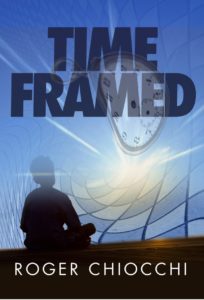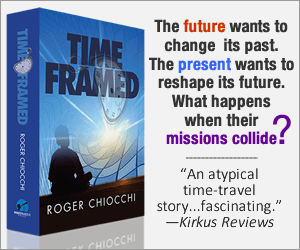
Author Roger Chiocchi
I once read that 85% of all people said they wanted to write a book. Not surprisingly, only about 10-15% actually sat down behind their keyboards and began to write. I don’t remember the exact percentage of people who actually finished their book, but I would venture to guess it was less than 1%.
It’s not easy. Even for a non-fiction book where the author is an expert in the subject matter, it takes a great deal of time and effort. For fiction, it’s even harder (I’ve written both and I’ve always told my friends, only half-jokingly, “It’s a lot harder when you have to make it up.”) There are so many elements that have to come together to form an understandable and enjoyable whole (concept, plot, characters, settings et al) in a fictional story that it really exponentializes the complexity of the crafting and writing.
But let’s start with the over-riding element critical to the success of your book: The Concept.
So what is a book’s concept? If you ask a dozen authors, you’ll probably get a dozen different answers. To me, it’s quite simple: in the broadest strokes, it’s the theme of your story, what your story is all about. It’s sort of like the 30,000 foot perspective we hear so much about in business. It’s major trends, not details.
Let me give you an example of a story concept:
A young girl going through puberty uses her telekinetic powers to retaliate against classmates who have been bullying her.
Can anyone guess what book that’s the concept for?
Most Stephen King fans will know that it’s the concept behind his thriller, Carrie.
So what are the elements of a good story concept? These are some of my subjective elements:
- It has to be Interesting – duuuuhhhh!, of course it has to be interesting, at least to a certain audience; but remember, what’s interesting to a 17 year old male scifi fan will probably not be interesting to a 35 year old female romance novel fan. So know your audience. Make sure your concept will be interesting to them, even if you’re focusing on a very tightly defined audience.
- It has to have an inherent conflict – anyone who’s ever taken a course in dramatic literature knows that without conflict, you don’t have a story. ‘Nuf said. (NOTE: I’ll be addressing plot structure in subsequent blogposts)
- It has to have a hero – in academic circles, this is known as a protagonist. There has to be someone the reader can identify with, share the same feelings with as they both proceed through your pages.
- It has to have a barrier – this could be a person (the “antagonist”) or some sort of natural barrier – the environment, a mountain, i.e. something inherent in nature which stands in the way of your hero achieving her or his goal.
So those are the basics. If you don’t have those elements in your concept, you’re not ready to write; you simply do not have an idea for a book yet. But, not to worry, sometimes the elements don’t fall into place until you sit yourself down and really start thinking about them. Here’s something you can do: if you have an idea for a book, try writing an overall concept statement and then identify all of the bulleted elements above. This will set you on your way.
Now here are two other elements that can make your concept even stronger:
- The “long tail” concept – I think most really interesting fiction occurs at the long tail of the bell curve. What do I mean by this? Well, most of us are “normal” and mostly do “normal things;” hence, we’re at the middle of the bell curve…most of the time! But every once in a while we venture out from the safety of the middle and do something different. That’s the beginning of a great story. (of course, there are stories out there about normal people doing “normal” things, but the characters have to be extremely well developed and interesting – Twain, Hemingway and Fitzgerald were excellent at that skill)
- Dilemma – a “one-sided” conflict is enough to build a good story around. But when you have a “two-sided” conflict, i.e. a dilemma, that makes your story idea even stronger. Think about it, in Romeo and Juliet, both main characters are faced with a dilemma: should they opt for true love or family loyalty? In Sophie’s Choice, the main character has to make a life or death decision between her two children. In the Wizard of Oz, Dorothy Gale has to choose between a “dull” but safe life in Kansas vs. a high risk/high reward life in the magical Land of Oz.
So let’s take a look at some concepts for fictional stories and see how they stand up:
Gone With the Wind: A young sassy, tempestuous Southern Belle is forced to deal with the demise of the Old South, the only way of life she has ever known.
This is definitely a conflict as Scarlet has to “adapt” to a new kind of life much different than the one she was used to. The story is spiced up by the characterization of Scarlett, herself, as well as her roller-coaster relationship with another highly defined character, Rhett Butler.
The Firm: A young lawyer struggles with his own personal ethics as he learns the prestigious law firm he works for has a dark underside.
In John Grisham’s landmark novel, the main character, Mitch McDeere, is confronted by a moral dilemma: should he “look the other way” and enjoy a life of wealth or should he expose the firm for what it really is?
The Adventures of Huckleberry Finn: A young rogue boy “escapes” from civilization and joins a runaway slave on a trip down the Mississippi where they learn about the true nature of humankind.
Ernest Hemingway once said, “All modern American literature comes from one book by Mark Twain called ‘Huckleberry Finn.” And he was right. However, I chose this as an example because despite the book’s greatness, the concept does not really have a strong conflict or dilemma. Yes, Huck wants to escape from “‘sivilization,” but it’s really more about the characters. Twain was a master in developing strong, sometimes quirky, characters with unique ways of speaking. He had a superb ear for interesting dialogue. What I also loved about the book was Twain’s subtle affront to racism: throughout the story, the character with the most common sense and ingenuity is none other than Jim, the runaway slave.
Now for my most recent book, Time Framed, I’d write the concept like this:
Family members from the future try to alter the past while family members in the present try to reshape the future each to avoid the consequences of a multi-generational family curse at the expense of the others.
Now, admittedly, that’s a little longer than the others, but, heck, it’s a complex story that involves time travel and alternate realities. As we proceed through these tutorials, I’ll guide you through how this developed into a plot, characters and all the other elements of storytelling.
So there you go: start with a strong concept and build from there. If you’re an aspiring writer and have an idea for a book, try writing the overriding concept down in one sentence and see where it takes you. Ask yourself if your concept has all the elements I mentioned above.
If you’d like me to take a look at it, just contact me on the form below.
If you would like to view other posts in this series, please click here.



